Ultimate Coyote Hunting Guide
Tips, Tricks, and Strategies
By Randy Tucker | Updated:
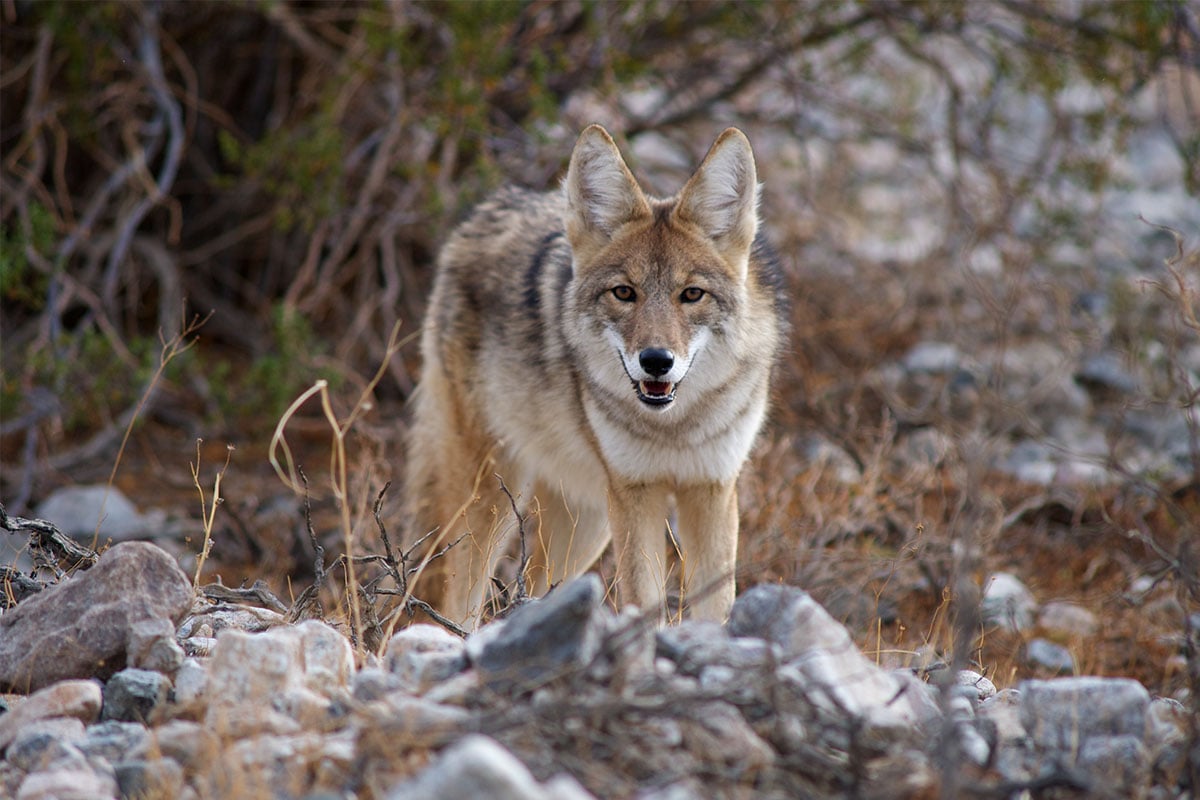
Coyotes are the most adaptable, intelligent, and resilient predators in North America. Learning a few tricks to successfully hunt this wild dog, an animal so regarded by Native Americans that nearly every tribe called them the trickster, can increase your success.
Coyotes can be hunted any time of year, and any time of day. Specific hunting tips can raise your chance of success dramatically if you choose to follow these techniques.
An example of how tricky, the trickster can be came from decades ago when I was a high school kid.
Coyotes on the Prowl
A friend I played football with was losing piglets every few nights from their pen. Pat lived below the tiny hamlet of Crowheart, Wyoming at his family’s farm on Willow Creek. One morning another piglet was missing but this time the culprit left a clear paw track in the mud created by a quick passing thunderstorm the day before.
It was clearly a coyote track.
Pat decided to wait inside the pen for the intruder that night. He had a 12-gauge single-shot shotgun with him that he laid across his lap. He made a perch inside the pen just after sunset and waited.
Inevitably, he fell asleep but was startled by the sound of squealing pigs. In the dim glow of a yard light he spotted a coyote in the pen.
Simultaneously the coyote spotted Pat. Coyotes are quick, agile, and highly intelligent. As Pat brought the shotgun up to fire, the Coyote sailed over the six-foot board boundary fence. All that lead shot sailed harmlessly into the darkness.
Coyote hunting can be that way, both exhilarating and frustrating simultaneously.
Six Coyote Techniques that Work Day, Night or Twilight
You can hunt coyotes any time of day, and any day of the year. They don’t migrate, they’re territorial and their habits are as bad as ours at times, making predictions of where and how you’ll find them much easier for the hunter.
Let’s start with daytime coyote hunting.
Daylight Hunting
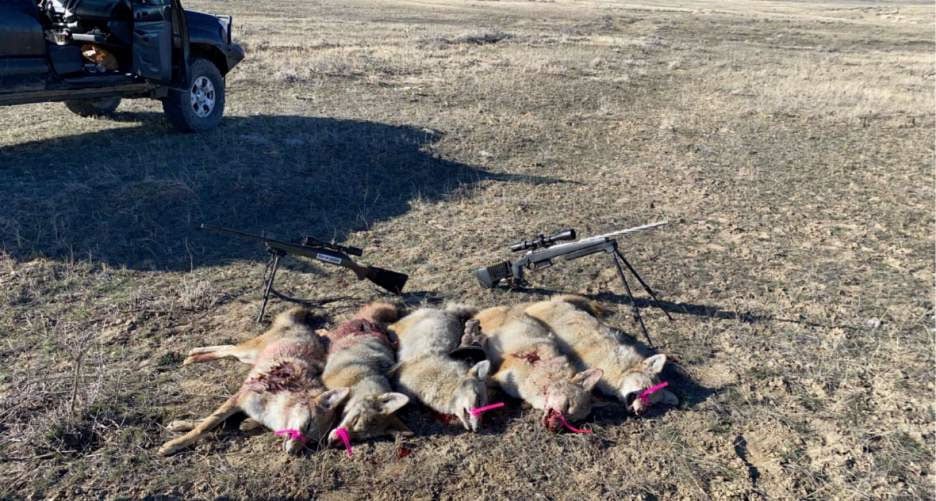
I’ve seen coyotes calmly sunning themselves, or diving into windrows of newly mown alfalfa hunting for mice. I’ve watched them stand completely still, not moving at all, on -30 degree mornings only to see them pounce, breaking through a crust of snow and bringing out a field mouse. Their patience and innate hearing are remarkable.
I’ve also spotted them briefly in the open along a 70 mph highway. If you slow down, even 10 miles per hour, they’ll bolt into cover. They know what a pickup coming to a stop on the highway can mean for them.
There is a big difference between spotting a coyote at random and finding one on a hunt. Let’s talk about daylight hunting.
A Variety of Calling Techniques
Coyote calls were once the realm of the gifted singer, a hunter who could mimic the sound of a wounded rabbit, downed goose, or another animal a coyote might hear and come running to for a free meal. These masters of the audible arts sometimes used their own voice, but often had a reed, blade of grass, or other natural material to help in creating that sound.
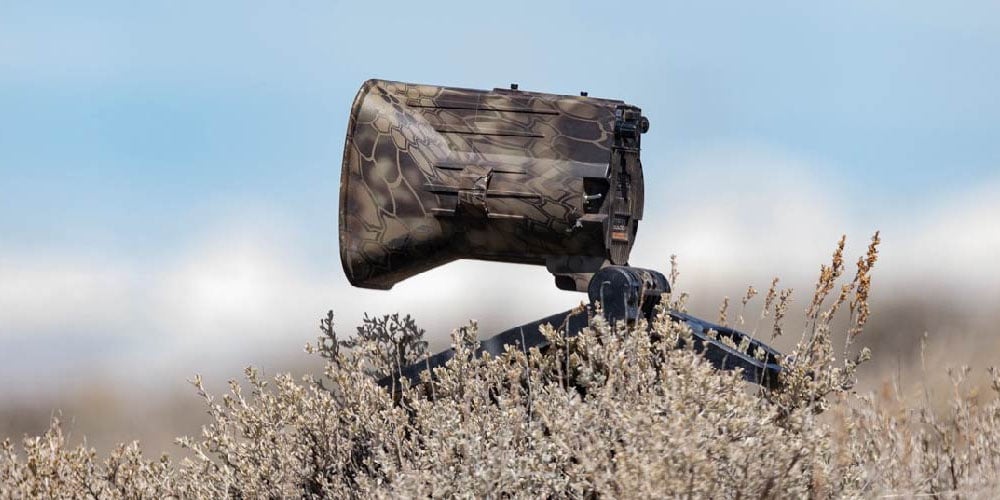
Now you can purchase calls that still require skill to use, or you can use electronic calls, devices that make the sound for you. Some calls are standalone devices, others are apps on cell phones you can broadcast via Bluetooth on a set of battery powered speakers set a few yards from your blind. Technology has made the art of the call significantly easier to do.
Calls by themselves are no guarantee of success. A few years ago my son Brian and my son-in-law Adam set up with me on a cold January day north of Lusk, Wyoming on a friend’s ranch. We were hidden pretty well in winter camouflage gear and had an electronic call working. This call created various sounds that coyotes will either come in on or will answer.
That afternoon was a great hunt, but we never spotted a coyote. Instead, we had three different groups of coyotes answering our call. The 15 mile per hour northwest wind played tricks on the location of the sound, but we could tell there were two groups of coyotes somewhere to the north of us, and one to the southwest.
Another time we used the same technique along Little Muddy Creek in central Fremont County, Wyoming. We didn’t get an answer from any coyotes on the wounded rabbit call, but two different American eagles flew in just a minute or two after we broadcast the first call. It’s not just coyotes that are listening.
Tips on Setting Effective Decoys
Calls combined with decoys, usually the outline or sometimes a full body decoy of a coyote are great together. They only work in daylight, but they can enhance a hunt.
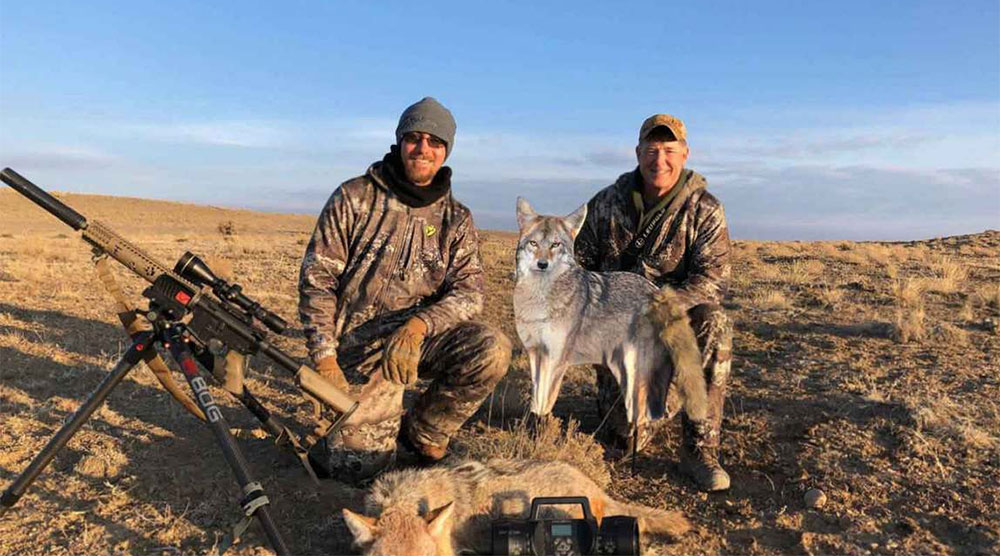
Setting the decoys and avoiding scent trails on them is the most important part of location. It’s not duck or goose hunting, where it’s the more the merrier with waterfowl in terms of decoys. One silhouette or full body decoy is usually enough. Keep them upwind of where you think a coyote may discover them.
Even the hint of plastic, diesel fuel, or a ham sandwich, much less your rancid boots will tip off a coyote and they’ll look elsewhere.
How to Find Coyotes
Sometimes your best friend is patience. You sit and wait, glassing an area with a variable power spotting scope. You can’t just plant yourself in the pumpkin patch and hope for the best. You’ll need to find signs of coyote activity, maybe a few prints in the snow or mud, a pile of scat, or even the signs of a coyote meal, as in a few duck wings, some rabbit parts, or other byproducts along a trail. A good coyote hunter is an expert on telling the difference between the unique droppings that myriad predators leave on the ground.
With spotting comes long range shooting most of the time. Have a range marker set in advance in all directions from your location. It doesn’t need to be a manmade marker, that scent will warn the coyote. Choose a tree, a rock, or a ridgeline, use a range finder to mark the location mentally, and have your rifle adjusted to that range before the coyotes come in. If the ridge is 500 yards away, have your scope set to 500 yards and wait for the coyote to come across it. Boom, one shot, one coyote.
Being set allows you to have shooting sticks, bipods, or even a mound of dirt as a rest prior to firing a shot.
How to Hunt Coyotes After Dark
Many avid coyote hunters shun the daylight and have their greatest success after the sun sets. Night vision optics are nothing short of miraculous and are now widely available on the consumer market. This was a technology once reserved for military applications, but thermal imaging has revolutionized coyote hunting.
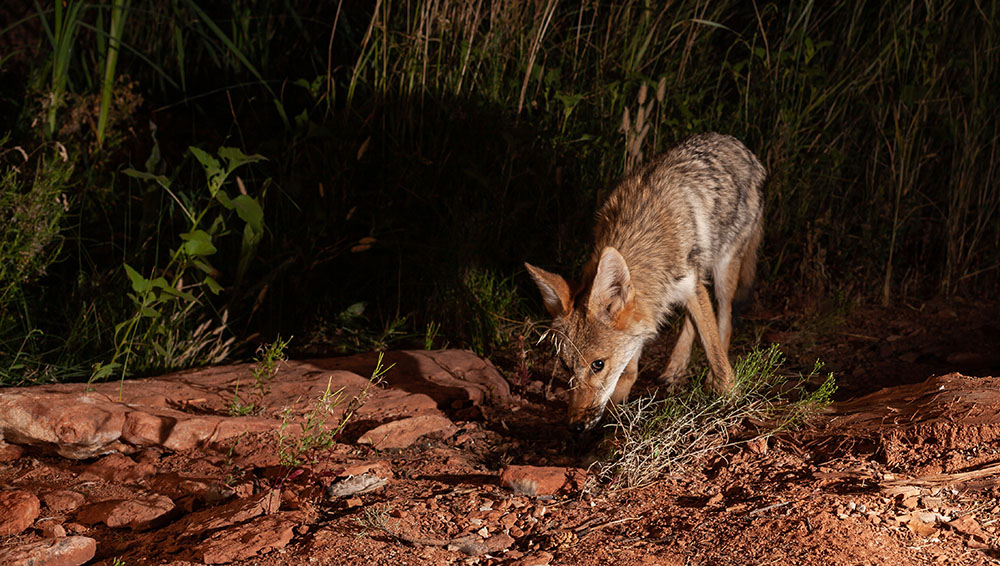
A benefit of this style of hunting is that it takes one of the three amazing senses that coyotes possess away from them, leveling the playing field metaphorically for a hunter. Coyotes see better than we can, often better than many people can with binoculars or a spotting scope. That’s one of the reasons Native Americans held them in such high regard. They can seem to appear out of nowhere, even when you've spent hours working over the area they suddenly appear in.
At night, they don’t have that option, and all the blended gray, white and brown fur they carry is useless when trying to hide from a thermal imaging device. Hot or cold nights don’t matter, you can’t hide a heat signature.
Calling at night, combined with thermal imaging is a double-whammy on coyotes. At night a coyote will rely on its nose and ears to find food. That nose will smell you long before you ever see, hear, or even spot a heat image. Knowing the direction of the prevailing wind is an important consideration in coyote hunting as well. Keep the wind in your face, and your scent will carry away from the direction you’re set up to shoot.
When coyotes do come in at night, they often come much closer than in daylight, so your choice of firearm needs to be adjusted as well. Let’s finish this up with a brief discussion of the types of coyote weaponry that most successful hunters carry.
Best Calibers & Gauges for Coyote Hunting
There are two considerations in selecting the right cartridge for coyote hunting. One is range, the other is destructiveness.
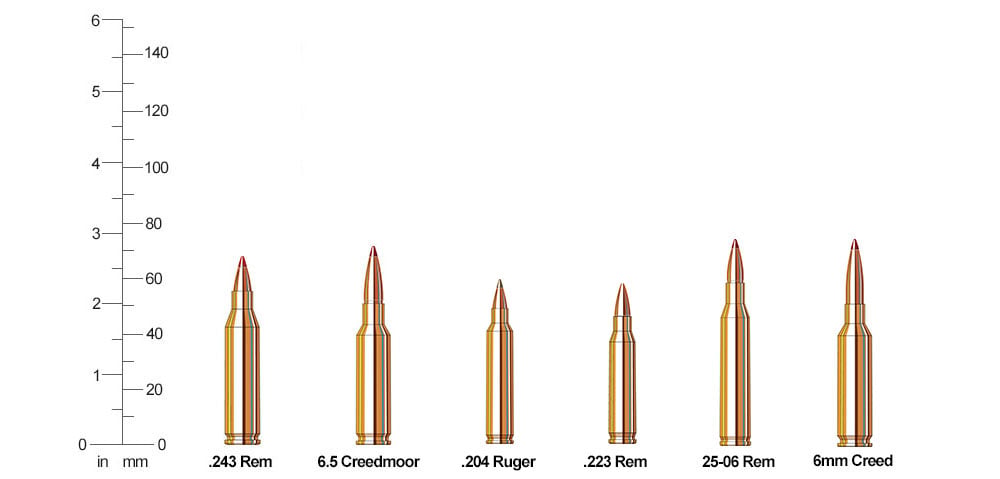
A lot of cartridges will do the job. You can long range shoot for coyotes with a massive .338 Lapua or a blazing fast 6.5 Creedmoor, but when you hit a coyote with a cartridge that powerful, there isn’t going to be much left in the way of a marketable pelt. If you’re just eradicating the varmint population, and don’t care about the fur, these are fine, but most hunters are also fur hunters.
A better long range weapon is something a little smaller, perhaps a 6mm Creedmoor, a .204, .22-250, .223 or a .243 with a lighter grain bullet.
Best Coyote Guns
Ruger American Predator in 6mm Creedmoor
The Ruger American was designed as an easy to carry, accurate varmint rifle. At 6.64 pounds, you can pack it all day in foot pursuit of coyotes. The 42 inch overall length makes it easier to move through brush with it strapped across your back, and the 22 inch barrel delivers accurate shots up to 800 yards.

Equipped with a recoil pad, sling swivels and drilled and tapped for a scope, the rifle is ready to go with just the addition of a strap and the scope of your choice.
A 13.5 inch pull, two-position safety, and a 4.06 trigger pull, combined with Ruger’s renowned quality makes this a step above in reasonably priced varmint rifles.
We’ve included a chart below listing the most popular cartridges for coyote hunting. As you can see, the 6mm Creedmoor fires the heaviest bullet at 108 grains, and delivers the most energy on target while falling in the middle among competing calibers in bullet drop at 400-yards.
The metric you don’t see is bullet drift. The 6mm Creedmoor was developed to fight the wind. At 300-yards, in a 30 mph crosswind you’ll only get three degrees of wind deflection with a 6mm Creedmoor.
That might not seem important if you’re hunting coyotes in heavily forested areas around the Great Lakes or the Mississippi drainage where strong winds aren’t an issue. But if you’re in the Dakotas, Montana, Wyoming, Colorado or Idaho, the wind is always a consideration on long shots. It gets windy on the Great Plains as well. Even a 10 mph crosswind when taking aim on a coyote in a Kansas wheat field can alter your shot enough to miss at 200 or more yards.
The magic of the 6mm Creedmoor cartridge is that it doesn’t blow up a coyote, keeping the pelt in workable condition, with minimal blemishes, allowing you to get top price when you take it to a fur buyer.
Most Popular Coyote Hunting Calibers - Velocity Ballistics
| Caliber | 100 yard velocity (ft/sec) |
200 yard velocity (ft/sec) |
400 yard velocity (ft/sec) |
||||||
|---|---|---|---|---|---|---|---|---|---|
| .204 Ruger (40gr) | 3482 | 3104 | 2435 | ||||||
| .22-250 (55gr) | 3253 | 2868 | 2186 | ||||||
| .223 Rem (68gr) | 2697 | 2449 | 1993 | ||||||
| .243 Win (100gr) | 2729 | 2509 | 2300 | ||||||
| 6mm Creed (108gr) | 2786 | 2618 | 2299 | ||||||
Most Popular Coyote Hunting Calibers - Energy Ballistics
| Caliber | 100 yard energy (ft/lbs) |
200 yard energy (ft/lbs) |
400 yard energy (ft/lbs) |
||||||
|---|---|---|---|---|---|---|---|---|---|
| .204 Ruger (40gr) | 1077 | 855 | 527 | ||||||
| .22-250 (55gr) | 1293 | 1004 | 583 | ||||||
| .223 Rem (68gr) | 1098 | 906 | 600 | ||||||
| .243 Win (100gr) | 1653 | 1398 | 980 | ||||||
| 6mm Creed (108gr) | 1861 | 1643 | 1267 | ||||||
Most Popular Coyote Hunting Calibers - Drop Trajectory
| Caliber | 200 yard drop (in) |
400 yard drop (in) |
|||||||
|---|---|---|---|---|---|---|---|---|---|
| .204 Ruger (40gr) | 0 | -13.2 | |||||||
| .22-250 (55gr) | 0 | -15.8 | |||||||
| .223 Rem (68gr) | 0 | -22 | |||||||
| .243 Win (100gr) | 0 | -18.6 | |||||||
| 6mm Creed (108gr) | 0 | -17.8 | |||||||
Coyote Shotgun Tips
Night hunters use the same platforms as day hunters, with the scope set at closer distances, but many use shotguns as well. Specifically, full choke 10 or 12-gauge shotguns. Many use shotguns designed for turkey hunting or Canada goose hunting.
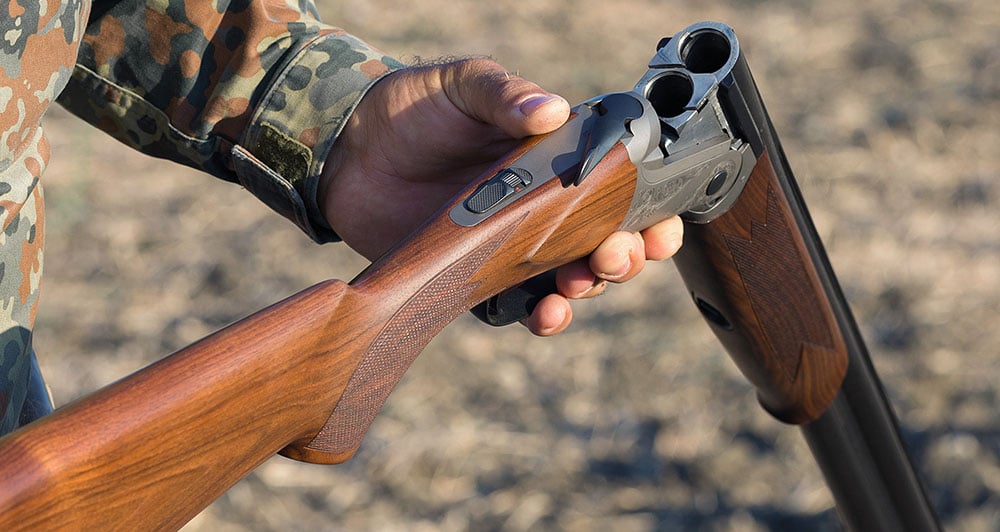
A shotgun is great at close distances, perhaps 60 yards or less with the right shells. The wrong shells, fired at close range can literally tear a coyote in half. Half a pelt, is no pelt at all.
Many experienced coyote hunters choose a shell like Hornady’s Heavy Coyote Magnum 12 gauge. The shell comes in either BB or 00 buckshot off the shelf. The BB flies at 1300 feet per second and the 00 buck 1150.
Other coyote hunters prefer Hornady Black in shorter 2 ¾ inch shells. In 00 buckshot it sends eight pellets down the barrel at a respectable 1600 feet per second, fast for a shotgun.
Shotguns are great at night with coyotes. With the shorter range shots you can get via night calling, and thermal imaging, shots less than 60 yards are much easier to get than the daytime.
Buckshot in 00 size sends eight .32 caliber size projectiles at a coyote. “Spray and pray” is the technique here, get four or five of those pellets in a 30” circle at 60 yards and you’ve got a great chance of dropping a coyote.
The slower speed, combined with the higher relative weight of buckshot doesn’t destroy the pelt at that range either.
Which Shotgun to Buy?
If you’re a coyote hunter, odds are you enjoy upland game bird hunting for pheasants, grouse and quail as well. Waterfowl is also something many varmint hunters enjoy when they’re not set up in a blind, calling in coyotes on a frozen morning.
If you hunt in these varied venues, you most likely already own a couple of shotguns, maybe an over-under for upland birds, and a pump or semi-automatic for waterfowl. With coyotes, rapid fire isn’t what you’re looking for, range is. That means you’ll want to look at turkey or goose guns with full choke barrels.
Ideally, you’re after a 30” pattern at 50-yards. That means a full choke, and a longer barrel.
I’ll admit, I’m biased, I grew up with my dad’s 20-gauge Remington 870. My first shotgun was a 12-gauge 870 I bought back in 1980. I bought my son a newer 870 with a ventilated rib in 1999 after he completed hunter safety as a 12-year old.
Yes, I’m going to say the Remington 870, chambered for 3” 12-gauge, with a ventilated rib in full choke. The balance, quickness, and tracking this shotgun offers for fast moving teal or zero-to-sixty pheasants is perfect for the sudden, adrenaline rush of a coyote coming into the blind.
Loaded with 2 ¾” Hornady Black shells, you’ve got a coyote killing machine in your hands. It should only take one shot at close range with a trained eye and a steady hand.
Final Thoughts
There is a lot to coyote hunting. You can have blind luck and shoot one while hunting something else, you can see them in a field, and have time to set up a long shot, or you can deliberately hunt these cunning predators.
The amount of technology, the amount of money and time you want to invest, and the location you intend to hunt are all considerations to think about long before you load up in the truck and head for the wilderness.
Good days aren’t measured in coyotes taken but in the thrill of the hunt.